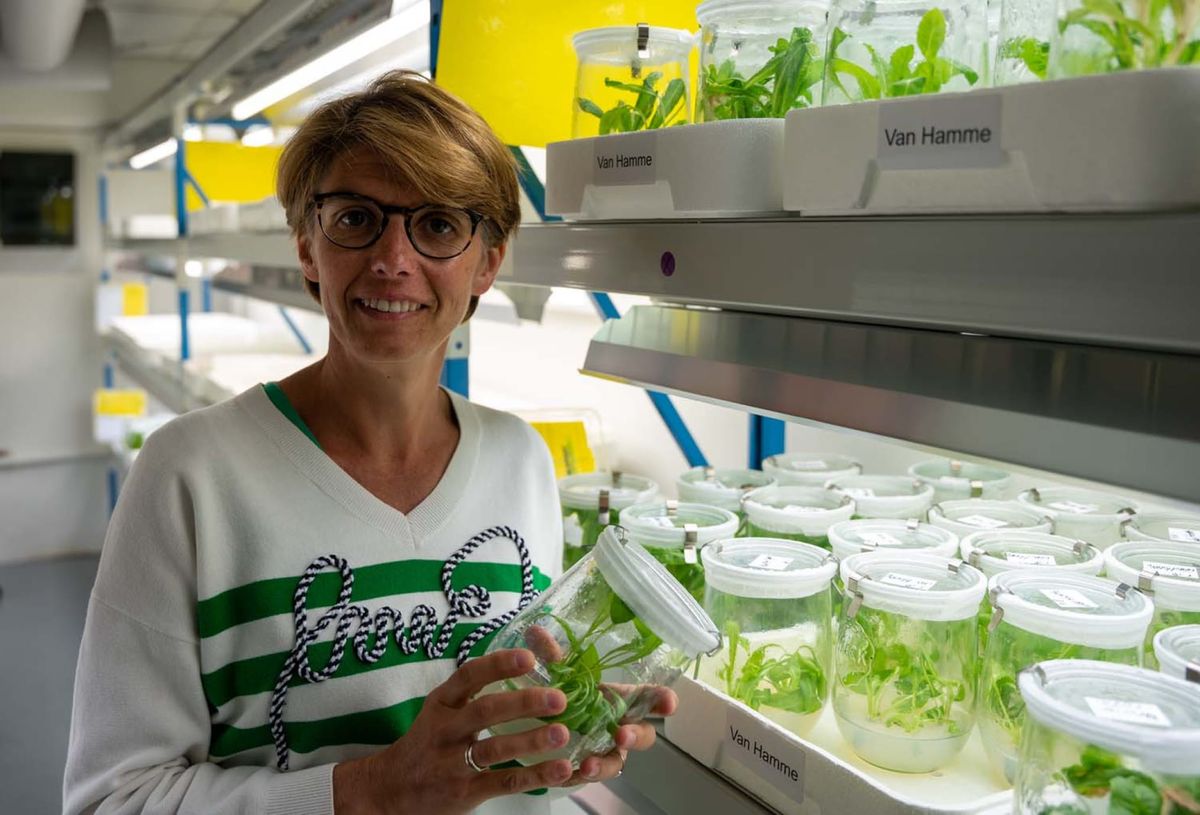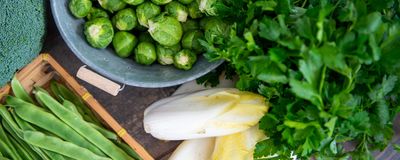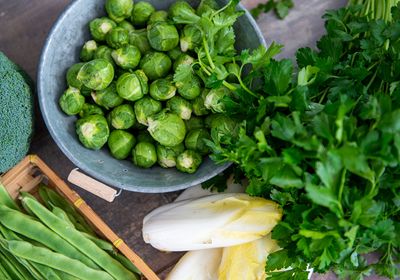ABOVE: An individual’s palate for the divisive bitterness of vegetables is a blend of genetic predisposition and personal preference. ©iStock, philipimage
Love them or hate them, vegetables are a staple at the dinner table—whether served plain or dressed up. For many, Brussels sprouts and other leafy vegetables share a distinct bitterness that divides opinions. While some eagerly tuck into their meal, others push the greens around their plate to avoid them altogether. Researchers have tried to get to the root of how and why people experience the same vegetables so differently and how to make these flavors more enjoyable. The answer lies in a mix of genetic and individual factors, which play a role in shaping personal preferences.

A Sprout of Genetic Insight
Taste buds cover your mouth and throat, opening a world of flavors: sweet, salty, sour, bitter, and savory (umami). These taste buds contain receptor cells that detect these distinct notes. The taste receptor type 1 (TAS1R) gene family, comprised of three genes, governs the detection of sweet and savory flavors. In contrast, the taste receptor type 2 (TAS2R) family, responsible for sensing bitterness, includes dozens of genes. One of the most studied bitter receptors is TAS2R38, which detects compounds like PTC (phenylthiocarbamide) and PROP (6-n-propylthiouracil).1 Although vegetables don’t directly produce these, many cruciferous plants contain chemicals similar to PTC and PROP called glucosinolates.2
Although everyone has the TAS2R38 gene, also known as the “taster gene,” the variants that someone inherits determine their sensitivity to tasting compounds like PTC, PROP, and glucosinolates. Those with two copies of a “sensitive form” of the gene are considered “supertasters” and may find certain greens to have an intense bitterness, while those with one or two copies of other variants or a “non-sensitive form” may experience a milder flavor.
“If you take people who have two copies of a sensitive form of TAS2R38 and compare them to people who have two copies of the insensitive form of TAS2R38, they will have a marked difference in their perception of Brussels sprouts, broccoli rabe, and such,” said Paul Breslin, a geneticist and biologist at Rutgers University and the Monell Chemical Senses Center, who studies the genes responsible for taste perception and how variations of these genes lead to differences in receptor function.3
Breslin’s team conducted a taste test using uncooked glucosinolate-rich vegetables (such as Brussels sprouts, broccoli, and kale) and non-glucosinolate-producing vegetables (like bitter melon, spinach, and endive).4 They found that, compared to participants carrying “non-taster” copies of the gene, supertasters reported glucosinolate-rich vegetables as more bitter. “It’s a remarkable finding,” he added. “It’s showing that a single gene, or the copies and forms of this gene, that you have in your genome can have an impact on how you taste your veggies.”
These genetic differences not only explain individual taste experiences but also inform agricultural practices aimed at making these vegetables more palatable to a broader audience. Over the last 30 years, farmers have selectively bred new varieties of Brussels sprouts that produce lower levels of glucosinolates. While cooking methods have also evolved, the Brussels sprouts found in grocery stores today are a far cry from the bitter variety many remember from their childhoods. For many, this is a welcome improvement. For Breslin, who is homozygous for the non-taster copies and enjoys the intense bitterness of all kinds of food, it also boils down to a matter of personal taste. “It's fascinating. I mean, we have this strange love affair with bitterness sometimes, and it varies with culture too.”
A Sliding Scale for Bitterness
Beyond cruciferous vegetables like Brussels sprouts, researchers are turning to genetic engineering and crop breeding to modify bitterness for both industrial and consumer needs. Chicory, a member of the Asteraceae family, is a recent target.5 This versatile plant includes leafy greens and a crunchy root, with its distinct flavor stemming from another class of bitter compounds called sesquiterpene lactones, detected by TAS2R46.6

“[Industrial] chicory is mainly cultivated for its root, which contains inulin,” explained Katrijn Van Laere, a plant scientist at the Flanders Research Institute for Agriculture, Fisheries and Food. Inulin is a prebiotic fiber that stimulates gut health. “We have to do a lot of chemical processing to remove the bitterness to be able to extract the inulin. If we could end up with a cultivar which does not produce any more of the bitterness compounds, the extraction of inulin would be more efficient.”
Leafy chicory varieties, like Belgian endive, are prime targets for genetic modifications to enhance flavor. Van Laere and her colleagues identified four genes involved in sesquiterpene lactone production and used CRISPR to generate chicory plants with reduced levels of bitterness in their leaves and roots.7,8 However, Van Laere noted the need to tailor bitterness for different palates. “It turns out that mainly the children and younger people don't like this bitterness, but older people lose a bit of the taste receptors in their mouth as well. So, they prefer to have it more bitter.”
The interplay between genetics and personal taste highlights the complexity behind why some people love bitter vegetables while others can’t stand them. Advances in tools like CRISPR offer exciting opportunities to dial up and down bitterness, making vegetables like chicory and Brussels sprouts more appealing to diverse palates. However, global genetically modified organism restrictions remain a significant hurdle, slowing the path from lab to farm to the dinner table. In the meantime, researchers like Van Laere are leveraging traditional breeding methods and genetic screening to identify natural mutants from a sprawling greenhouse of plants. These efforts demonstrate that innovation and flavor can continue to transform how people experience vegetables.
- Fox AL. The relationship between chemical constitution and taste. Proc Natl Acad Sci U S A. 1932;18(1):115-120.
- van Doorn HE, et al. The glucosinolates sinigrin and progoitrin are important determinants for taste preference and bitterness of Brussels sprouts. J Sci Food Agric. 1998;78(1):30-38.
- Bufe B, et al. The molecular basis of individual differences in phenylthiocarbamide and propylthiouracil bitterness perception. Curr Biol. 2005;15(4):322-327.
- Sandell MA, Breslin PAS. Variability in a taste-receptor gene determines whether we taste toxins in food. Curr Biol. 2006;16(18):R792-R794.
- Poli F, et al. Variation in the content of the main guaianolides and sugars in Cichorium intybus var. “Rosso di Chioggia” selections during cultivation. Food Chem. 2002;76(2):139-147.
- Brockhoff A, et al. Broad tuning of the human bitter taste receptor hTAS2R46 to various sesquiterpene lactones, clerodane and labdane diterpenoids, strychnine, and denatonium. J Agric Food Chem. 2007;55(15):6236-6243.
- De Bruyn C, et al. Establishment of CRISPR/Cas9 genome editing in Witloof (Cichorium intybus var. foliosum). Front Genome Ed. 2020;2:604876.
- De Bruyn C, et al. Identification and characterization of CYP71 subclade cytochrome P450 enzymes involved in the biosynthesis of bitterness compounds in Cichorium intybus. Front Plant Sci. 2023;14:1200253.




